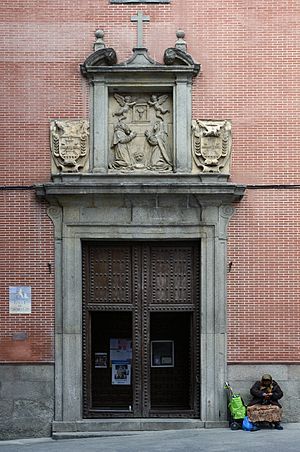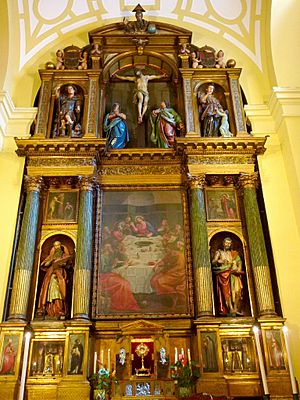Monastery of Corpus Christi las Carboneras facts for kids
Quick facts for kids Monastery of Corpus Christi las Carboneras |
|
|---|---|
| Native name Spanish: Monasterio del Corpus Christi las Carboneras |
|
 |
|
| Location | Plaza del Conde de Miranda, 3, 28005 Madrid, Spain |
| Architect | Miguel de Soria |
| Architectural style(s) | Spanish Baroque architecture |
| Official name: Monasterio del Corpus Christi las Carboneras | |
| Type | Non-movable |
| Criteria | Monument |
| Designated | 1981 |
| Reference no. | RI-51-0004500 |
| Lua error in Module:Location_map at line 420: attempt to index field 'wikibase' (a nil value). | |
The Monastery of Corpus Christi las Carboneras (which means "Monastery of the Body of Christ of the Coal Women") is a special home for nuns in Madrid, Spain. It was started in 1607 by a nun named Beatriz Ramírez de Mendoza, who was also a countess.
The monastery gets its unique name, "las Carboneras," from a painting of the Virgin Mary. This painting was found in a coal yard (a place called a carbonería in Spanish). The main building was designed by Miguel de Soria in the early 1600s. In 1981, it was officially recognized as an important historical site in Spain. Today, the nuns at the monastery are famous for selling delicious homemade sweets!
The church inside the monastery is a great example of early Baroque style in Madrid. It has one main hall, called a nave, with three sections. The ceiling is shaped like a half-cylinder, known as a barrel vault, with arched openings for windows. The choir, where the nuns sing, is raised up.
Amazing Art: The Reredoses
A reredos is a large, decorated screen or wall structure behind the altar in a church. The main reredos in this monastery's church is a beautiful work of art. It was created by Antón de Morales in 1622. The paintings on it were done by Vicente Carducho, a famous artist of that time.
Main Reredos Details
The bottom part of the reredos, called the predella or banco, has paintings of several saints. From left to right, you can see Saint Augustine, Saint Anne, Saint Dominic, Saint Joachim, Saint Clare, Saint Joseph, Pope Gregory I, Saint Lawrence, and Saint Stephen.
In the middle section of the reredos, there's a large painting by Carducho called Last Supper. This painting shows Jesus having his last meal with his disciples.
On the left side of the main reredos, there's a statue of Saint Jerome, who was a very important saint. Above him, there's a smaller painting of Saint Teresa of Ávila looking at Christ being whipped. On the right side, you'll find a statue of Saint John the Baptist. Above him, there's a small painting showing Saint Francis of Assisi and the Good Shepherd.
Other Reredoses
There are two other reredoses located on the walls near the main altar. It's not completely certain who painted them, but some people think Vicente Carducho might have been the artist.
The reredos on the right wall has a painting of Saint Paula admiring the Christ Child. Its bottom part shows paintings of a holy martyr, the Resurrection, and Saint Agnes. At the very top, there's a painting of the Virgin of the Immaculate Conception.
The reredos on the left wall features a painting of Saint Jerome as a penitent (someone showing sorrow for their sins) in the desert. The bottom part has paintings of Saint John the Baptist, the Ascension, and Saint Sebastian. The top part shows the Annunciation, which is when the Angel Gabriel told Mary she would have Jesus.
Finally, in the last section on the right side of the church (called the Epistle side), there's a reredos dedicated to Saint Anthony of Padua. It has beautiful wood carvings that look like the work of Pedro de la Torre.
See also
 In Spanish: Convento de las Carboneras del Corpus Christi para niños
In Spanish: Convento de las Carboneras del Corpus Christi para niños


